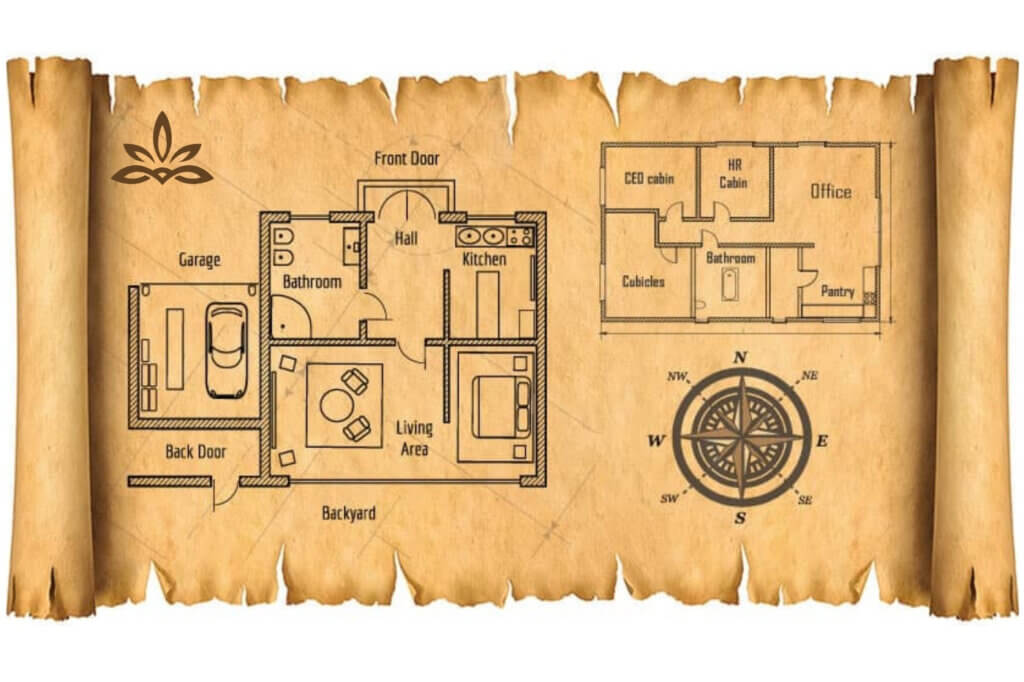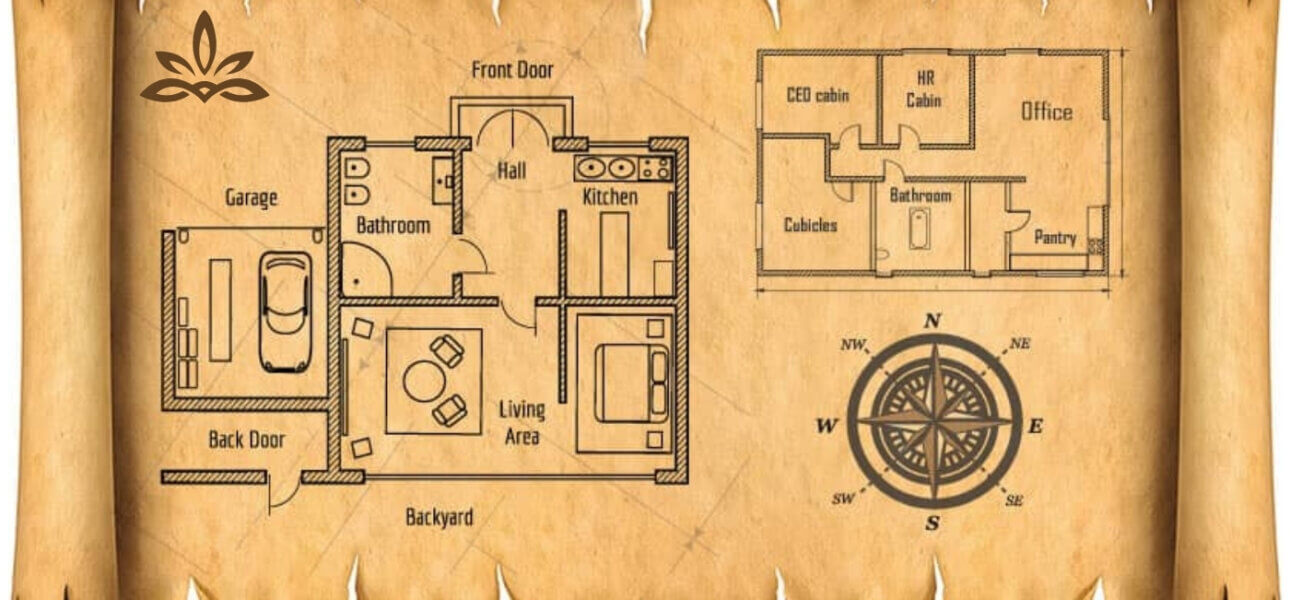A courtyard can transform a villa plot from “just a house” into a light-filled, breezy home. In Chennai’s warm climate, a well-planned court improves ventilation, brings nature inside, and creates a calm family zone. If you are planning your home at Padappai or the Oragadam belt, should you go fully private or choose a semi-private court that welcomes guests too?

What Do We Mean by “Private” and “Semi-Private”?
Private courtyard
- Fully inward-facing, not visible from the main door or living.
- Accessed mostly by family from bedrooms, pooja niche, or a small sit-out.
- High compound or internal screens for complete seclusion.
Semi-private courtyard
- Centrally placed near living and dining.
- Visible from key common areas, sometimes even from entry foyer.
- Uses low planters, jali walls, and level changes to maintain partial privacy.
Vastu Basics for Courtyard Placement
While Vastu is a guiding compass, adapt it to your site, wind, and sun:
- Brahmasthan (centre): Keeping a light, open zone here is considered positive. A skylit atrium or courtyard works well.
- North and East: Favoured for light and prosperity. An open-to-sky court here can brighten the home through the day.
- South and West: Warmer zones. If you place the court here, use shading devices, pergolas, creepers, and water elements.
- Pooja proximity: Many families prefer the court near the pooja room for morning light and calm.
Tip for Padappai conditions: Morning sun from the east is gentle and useful for drying and health; harsh west sun needs shading.
Privacy Spectrum: How to Decide
Choose a private courtyard if you:
- Want a safe, exclusive play nook for kids or elders’ yoga time.
- Prefer to meditate or do pooja without interruptions.
- Have a compact plot where direct street views are common and you need a personal retreat.
Go for semi-private if you:
- Love entertaining and want a green backdrop to living-dining.
- Plan flexible zones where guests and family mingle.
- Need cross-ventilation that flows through the core of the home.
In many Velammal Garden plot layouts, a hybrid model works well: a small private court near the bedrooms plus a semi-private green court by the living.
Climate-Smart Design for Chennai/Padappai
- Ventilation: Align openings to capture the prevailing sea breeze (late afternoon) and allow hot air to escape through a high-level skylight or vent.
- Shade first: Use pergolas, bamboo screens, tensile canopies, or jaali brickwork on west and south sides.
- Materials: Kota/Balaji stone, terracotta tiles, and rough granite cope well with heat and rain. Non-slip finishes are important during monsoon.
- Green cover: Tulsi, jasmine, hibiscus, and native shade plants reduce heat gain and add fragrance. For low care, add areca palms and money plants in planters.
Functional Zoning Ideas on Typical Plot Sizes
600–900 sq ft built-up (on ~800–1200 sq ft plot)
- Pick one compact court: 6 ft by 8 ft.
- Semi-private option: between living and dining with a sliding screen.
- Private option: by the master bedroom with full-height planters and lattice.
1200–1800 sq ft built-up
- Two courts work: a semi-private atrium in the centre and a private mini-court outside the kid’s room.
- Add a narrow vertical garden to double as a privacy filter.
2000+ sq ft built-up
- Create a sequence: entry forecourt, central family court, rear meditation court.
- Use level changes or deck steps to signal public to private transition.
Detailing for True Privacy Without Feeling Boxed In
- Eye-level screens: 4.5–5 ft planters, bamboo cladding, or hollow clay blocks give privacy while letting air move.
- Top-lighting: A frameless skylight or polycarbonate roof with openable louvres keeps the court bright on rainy days.
- Sound softening: Grass pavers, water bowls, and shrub layers reduce street noise.
- Door strategies: Use L-shaped circulation so there is no direct line of sight from main door to private court.
Vastu-Friendly Décor Touches
- Place water features towards the north or northeast where practical.
- Keep clutter away from the centre. Use low seating, floor cushions, and a simple swing for warmth.
- Add brass diya stands or a tulsi vrindavan for a devotional feel that many Chennai families love.
Semi-Private Courts for Hosting and ROI
Buyers in the Oragadam job corridor often look for homes with lively common zones. A semi-private court:
- Makes small homes feel larger with borrowed light.
- Improves family interaction and doubles as a photo-friendly corner for festivals.
- Adds resale appeal, as many tenants enjoy indoor-outdoor dining.
If you plan to build now and hold for rental, a semi-private court near the living can be a smart choice. Explore plot options and plan ideas at velammalgarden.com.
Safety, Drainage, and Maintenance
- Drain slope: Keep a gentle slope to a concealed grated drain. Tie it to rainwater harvesting.
- Mosquito control: No stagnant water. Use pebbled basins with recirculating pumps, not open ponds.
- Night lighting: Warm LED step lights and up-lighters under plants for safety and ambience.
- Pet and child safe: Rounded edges for planters, non-toxic plants, and anti-skid flooring.
Budgeting: What to Expect
- Basic courtyard (6 ft by 8 ft) with flooring, planters, and a pergola can start budget-friendly when planned during construction itself.
- Skylight and custom jaali raise costs but deliver long-term comfort and appeal.
- Maintenance stays low with native plants, automated drip lines, and washable surfaces.
For plot-specific guidance and a walk-through of sample courtyard concepts, connect with the team at velammalgarden.com.
Quick Decision Checklist
- How private should it be on a daily basis
- Which direction gives the best light and least heat
- Can cross-ventilation be achieved with this location
- Is there a clear line of sight from the main door
- What screens, plants, or levels will protect privacy
- How will drainage and shade be handled through monsoon and summer
Sample Layout Combos You Can Copy
Option A: Privacy First
- Private court outside master bedroom in the northeast.
- High planters and a partial roof with openable louvers.
- Living gets clerestory windows to borrow light without exposure.
Option B: Entertainer’s Delight
- Semi-private court between living and dining.
- Jaali wall towards the entry, swing seat, and herb planters.
- Guest powder room tucked away to keep the court calm.
Option C: Hybrid for Families
- Compact semi-private court near dining plus a tiny private pooja court.
- Sliding slatted screens to switch from open to secluded as needed.
FAQs: Private vs Semi-Private Courtyards Vastu Plot Layout
Q1. Which is better for Vastu, private or semi-private courtyard
A. Both work if the centre stays light and clutter-free. For many Padappai homes, a semi-private central court brings balance, while a private court in the northeast supports meditation and pooja.
Q2. Where should I place water features in a courtyard as per Vastu
A. Prefer the north or northeast with gentle flow. Avoid creating glare or moisture near bedroom doors. Keep water recirculating and covered with a mesh to prevent mosquitoes.
Q3. How do I keep a semi-private court comfortable in Chennai heat
A. Use shade-first design. Add pergolas, fabric canopies, vertical greens, and cross-vent windows. Choose light-coloured stone and incorporate a misting line if needed.
Q4. Will a courtyard reduce my built-up area on a small plot
A. Not necessarily. A well-placed court replaces corridors, increases daylight, and improves ventilation, so the home feels larger. In MOFU-stage planning, test 6 ft by 8 ft as a starter court.
Q5. What is the simplest privacy solution without heavy walls
A. Layered planters at 4.5–5 ft height, bamboo or wood slats with 30–40 percent openness, and a swing or bench placed to turn the view inward. This works beautifully in semi-private courts.
Courtyards are not a luxury anymore, they are a climate-smart necessity for Padappai and Oragadam homes. Decide your privacy level based on lifestyle, then lock Vastu-friendly placement, shading, and drainage. When you plan your dream home at Velammal Garden, a thoughtfully designed courtyard will be the heart that keeps the whole house cool, bright, and happy.


